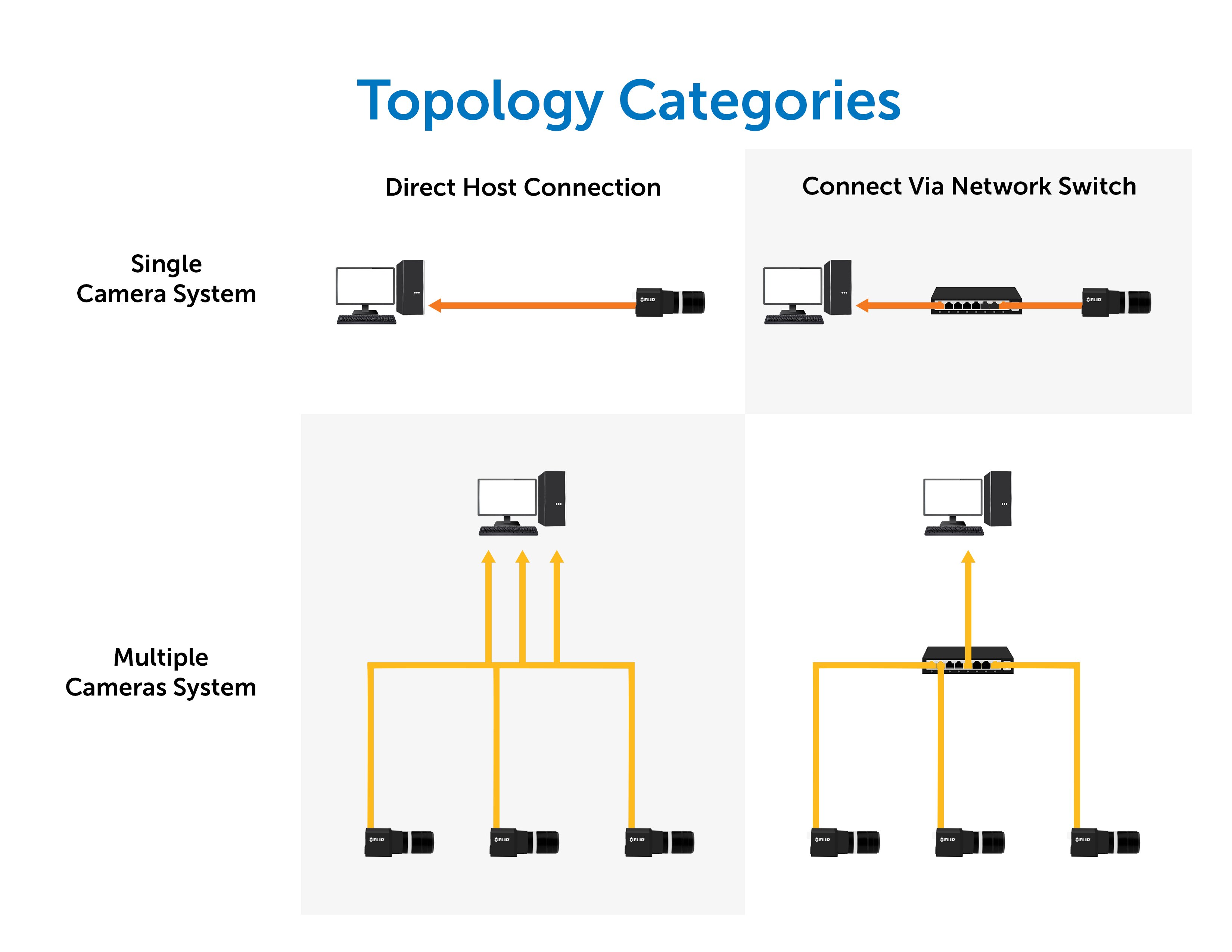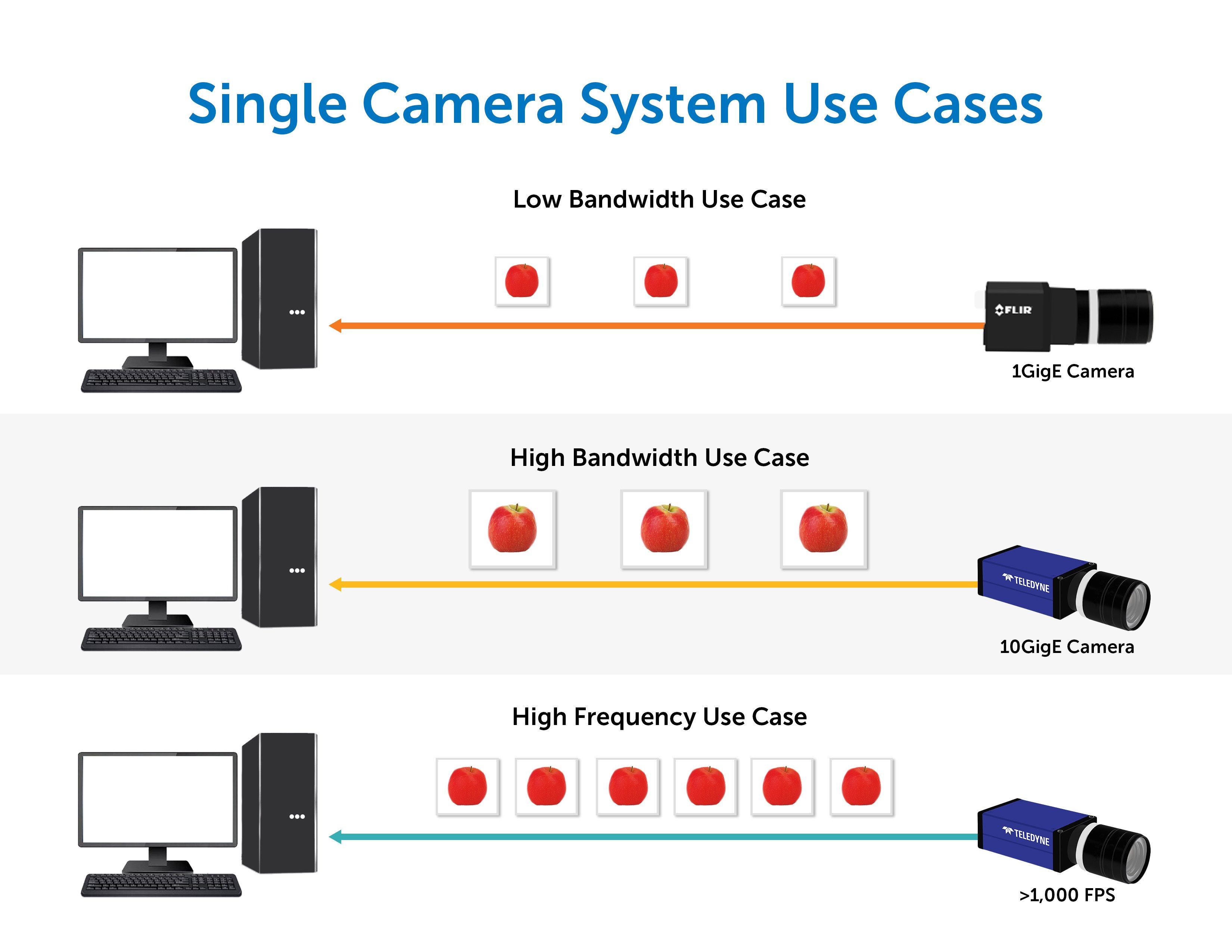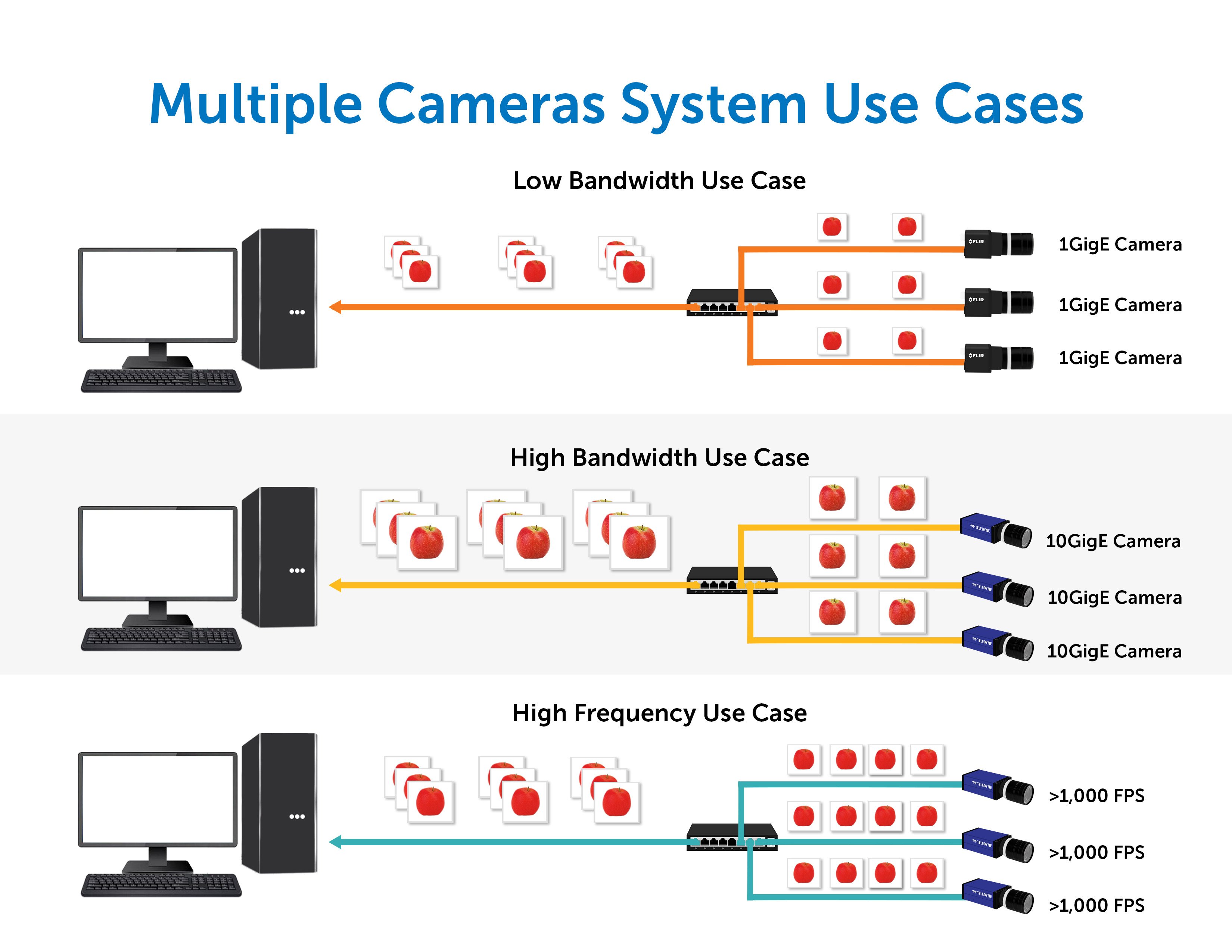Designing a Robust GigE Vision Camera System
Essential components and key considerations for high performance systems.
"A well-designed GigE camera system should NEVER lose any image frames." - Manny Romero, Senior Product Manager, Teledyne Vision Solutions.
Introduction
Gigabit Ethernet (GigE) cameras based on the GigE Vision standard have revolutionized industrial imaging by delivering fast, flexible, and cost-effective imaging solutions. These cameras offer several compelling benefits:
- High Speed: GigE Vision cameras continuously advance with higher-speed image acquisition and data transfer, evolving from 1GigE to 10GigE to 25GigE and beyond. This progression is essential for applications requiring rapid and real-time processing.
- Long Cable Lengths: Unlike other vision standards that are limited by shorter cable lengths, GigE Vision supports distances up to 100 meters with standard Ethernet copper cabling, and kilometers with network switches or fiber optics. This capability is beneficial for applications requiring cameras to be placed far from the processing unit or distributed across a large area.
- Versatility and Scalability: The use of standard network equipment allows for easy integration and scalability. Systems can be expanded with minimal additional cost or complexity, making GigE Vision an ideal choice for both small-scale and large-scale operations.
- Robust Data Transmission: GigE Vision incorporates robust data transmission mechanisms, ensuring reliable delivery of high-quality images even in demanding industrial settings. This robustness is critical in applications where data integrity and reliability are paramount.
Ensuring System Robustness
The foundation of any reliable GigE Vision Camera System is its robustness—the system's ability to operate consistently and without errors. This is particularly important in industrial and scientific settings, where minor disruptions can have significant consequences.
Achieving robustness requires careful planning and ongoing validation to prevent packet loss, which can undermine data integrity and system performance.
Prioritizing robustness from the beginning ensures smooth operation and maintains high-quality imaging.
To maintain a robust GigE Vision Camera System, it is essential to implement the following key approaches:
- Continuous Monitoring: Regularly observing system's performance to detect and address potential issues such as packet loss or retransmission acts as a preventative measure.
- Leveraging T2IR: Teledyne's Trigger-to-Image Reliability (T2IR) framework proactively diagnoses and troubleshoots system issues. T2IR provides essential tools for network diagnostics, bandwidth management, and advanced error handling, helping to optimize performance and prevent disruptions.
- Maintaining Data Integrity: Ensure that data transmitted across systems remain accurate and reliable. This protective approach is crucial for preserving the quality and consistency of imaging data, which is fundamental to system robustness.
Packet loss, even as low as 1-2% of packet retransmissions per frame, is a critical indicator of system robustness. When detected, it signals underlying issues within the system’s configuration or network that demand immediate attention to prevent further degradation in performance and data quality. Teledyne’s T2IR framework is specifically designed to diagnose and resolve these issues, ensuring your system's reliability is swiftly restored and maintained.
Overview of Topologies
GigE Vision Camera Systems can be configured in several topologies, each suited to different application requirements:

- Single Camera System with Direct Host Connection: The simplest topology, where a single camera connects directly to host adapter card. It is ideal for applications needing minimal latency and high reliability, with fewer points of failure.
- Single Camera System Connected via Network Switch: Here, a single camera connects to the host computer through a network switch. This topology is beneficial for systems requiring parallel processing across multiple PCs or for system backup via multicast, offering both efficiency and redundancy.
- Multiple Cameras System with Direct adapter Connection: Multiple cameras connect directly to a single host, using multiple network interface cards (NICs). This setup is suitable for synchronized data capture from multiple viewpoints, providing precise and coordinated imaging.
- Multiple Cameras System Connected via Network Switch: In more complex setups, multiple cameras connect to a host computer through one or more network switches. This topology is typically used when scalability and flexibility are essential, allowing integration of numerous cameras within a robust network infrastructure. Additionally, this topology is best suited when IEEE 1588 (PTP) is required in the application.
Crucial Components for Each Topology
For each topology, certain components are critical to achieving and maintaining system robustness. The table below outlines the importance of these components, providing a quick reference for where to focus optimization efforts:
Legend:
★☆☆ (1 Star - Low Importance): Optional for basic operation; useful for improving performance but not essential.
★★☆ (2 Stars - Moderate Importance): Important for achieving good performance and reliability; recommended in most cases.
★★★ (3 Stars - High Importance): Critical for optimal operation; necessary for avoiding significant issues or failures.
N/A: Not applicable or not needed for this specific topology.
Component/Topology |
Single Camera Direct |
Single Camera via Switch |
Multiple Cameras Direct |
Multiple Cameras via Switch |
|
Advanced Camera Capability |
★☆☆ |
★★☆ |
★★☆ |
★★★ |
|
Network Interface Cards (NICs) |
★★☆ |
★★☆ |
★★☆ |
★★☆ |
|
Quality Network Switches |
N/A |
★★☆ |
N/A |
★★★ |
|
High-Quality Ethernet Cables |
★★☆ |
★★☆ |
★★☆ |
★★☆ |
|
Bandwidth Management |
★☆☆ |
★☆☆ |
★★☆ |
★★★ |
|
Advanced Network Configuration |
★☆☆ |
★★☆ |
★★☆ |
★★★ |
|
Diagnostic and Monitoring Tools |
★★☆ |
★★☆ |
★★☆ |
★★☆ |
|
Software optimization |
★☆☆ |
★☆☆ |
★★☆ |
★★★ |
Looking Ahead: Optimization in Focus
Each topology has its own unique optimization needs to ensure system robustness. While some configurations may demand advanced network setups and high-quality components, others might require targeted software optimization to handle specific challenges.
In our next article, we will dive deeper into these optimization strategies, covering advanced camera capabilities, quality network switches, sophisticated network configurations, and both hardware and software optimization. For instance, typical out-of-the-box systems often have software resources on the PC that are not fully optimized, leading to conflicts between processes. A common issue arises when pre-installed software like antivirus programs consumes significant resources, particularly during updates or scans, which can interfere with image acquisition. Addressing these optimization challenges is crucial for maintaining a robust and high-performance GigE Vision system.
Use Cases for GigE Vision Camera Systems
Understanding how different topologies and their crucial components align with specific application needs is essential for optimizing GigE Vision Camera Systems. Whether configured with a single camera or multiple cameras, these systems can be tailored to support a wide range of applications, from basic monitoring to high-speed, high-resolution imaging. The key to selecting the right configuration lies in identifying the specific bandwidth and image capture frequency requirements of each use case, which directly influence the system's design and optimization strategies.

Low Bandwidth Use Cases
Low bandwidth scenarios are suitable for applications that require moderate data transfer rates, typically under 500 MB/s. These setups prioritize cost-effectiveness and simplicity, making them ideal for tasks that do not require the transfer of large amounts of data quickly.
- Single Camera: In low bandwidth use cases, such as basic quality control or simple surveillance, a 1GigE camera is typically used. This setup supports resolutions from 2 to 5 MP at moderate frame rates from 30 to 60 FPS). The network configuration is straightforward, with minimal software optimization needed.
- Multiple Cameras: For multiple camera setups, low bandwidth use cases might include simple multi-angle inspections or monitoring multiple conveyor lines. Using multiple 1 GigE cameras, the focus remains on simplicity, ensuring smooth data flow across devices without the need for complex integration.
High Bandwidth Use Cases
High bandwidth scenarios are necessary for applications requiring significant data throughput, with transfer rates exceeding 500 MB/s and potentially reaching several GB/s. These setups are essential for high-resolution imaging and detailed image analysis.
- Single Camera: In high bandwidth use cases, such as detailed inspection systems or advanced medical imaging, a 5GigE or 10GigE camera is typically employed. This setup supports high-resolution imaging, often above 5 MP, with frame rates of 60-120 FPS. The network infrastructure must be robust, with advanced software optimization to handle the increased data load.
- Multiple Cameras: When using multiple cameras in high bandwidth scenarios—such as in advanced manufacturing processes or multi-faceted scientific research—multiple 5 or 10 GigE cameras are used. These setups require a highly optimized network to manage multiple high-resolution streams, demanding detailed attention to network robustness and sophisticated software integration.
High Frequency Use Cases
High frequency use cases are defined by their need for very high line rates (1D line scan camera), high profile rates (3D camera), or frame rates, often exceeding 1000 FPS (2D area scan camera). These setups are crucial for capturing rapid events, where real-time processing and data transfer are paramount.
- Single Camera: For high frequency applications like motion analysis or high-speed production line monitoring, a 1GigE or 5GigE camera is used. These setups demand a high-speed network capable of managing real-time data processing, with critical software optimization to ensure data integrity at high frame rates.
- Multiple Cameras: High frequency scenarios involving multiple 5 or 10 GigE cameras are necessary for applications such as synchronized high-speed assembly line inspections or sophisticated motion analysis. These setups require the most complex network configurations and advanced software optimization to manage real-time data processing and synchronization across all cameras.
Summary of Use Cases
The table below summarizes the key features and considerations for both single and multiple camera system use cases. It directly compares various setups to help select the optimal configuration for an application.
Topology |
Single Camera Direct |
Multiple Cameras Direct or Via Switch |
||||
Use Case |
Low Bandwidth |
High Bandwidth |
High Frequency |
Low Bandwidth |
High Bandwidth |
High Frequency |
Typical Camera Type |
1 GigE Camera |
5GigE or 10GigE Camera |
1GigE or 5GigE Camera |
Multiple 1 GigE Cameras |
Multiple 5 or 10 GigE Cameras |
Multiple 5 or 10 GigE Cameras |
Primary Considerations |
Cost-effectiveness, simplicity |
High-speed and high resolution capture and transfer |
High-speed capture and transfer, real-time processing |
Cost-effectiveness, simplicity |
Detailed imaging, network robustness |
High-speed capture and transfer, real-time processing, synchronization |
Application Examples |
Basic quality control, simple image capture |
Detailed inspection systems, advanced medical imaging, sport analytic |
Motion analysis, high-speed production line monitoring, 3D profiling, line scanning |
Simple multi-angle inspections, multi-conveyor line product inspections |
Advanced manufacturing processes, multi-faceted scientific research |
Sophisticated motion analysis, high-speed assembly line inspections, volumetric measurements in research |
Data Volume |
Low |
High |
High |
Moderate |
High |
Very High |
Image Resolution |
Low to Moderate |
Moderate to High |
Low to Moderate |
Low to Moderate |
Moderate to High |
Low to High |
Frame Rate Requirements |
Moderate to High |
Moderate to High |
Very High |
Moderate |
Moderate to High |
Very High |
Network Configuration |
Simple |
Robust, high-performance network require quality network interface card |
High-speed network capable of handling large data volumes in real-time |
Simple |
Robust, high-performance network |
High-speed network capable of handling large data volumes in real-time |
Integration Complexity |
Simple |
Simple |
Complex |
Simple |
Complex |
Complex |
Software Optimization |
Less Importance |
Important |
Critical |
Important |
Critical |
Critical |
Summary and Conclusion
The article explored the essential elements of optimizing GigE Vision Camera Systems to meet a wide range of industrial and scientific applications. Each step is critical to achieving optimal performance - from understanding the importance of system robustness and selecting the right topology, to configuring your system to handle specific bandwidth and frequency requirements.
Key Takeaways:
- System Robustness: Ensuring your GigE Vision system’s is robustness is most important. With tools like Teledyne’s T2IR framework, you can monitor and maintain system reliability, preventing packet loss and ensuring data integrity.
- Topology Selection: The choice of topology—whether a single camera directly connected to an adapter, or multiple cameras integrated via network switches—has a significant impact on system performance. Understanding the strengths and limitations of each topology helps in configuring a system that meets the specific needs.
- Tailored Configurations: By aligning system configurations with the specific bandwidth and frequency demands of the application, the GigE Vision Camera System is both efficient and effective. Whether it is a low bandwidth setup for simple tasks or a high frequency configuration for capturing rapid events, the right setup is key to success.
Final Thoughts:
As you consider the strategies discussed, remember that system optimization is an ongoing process. The choices you make in configuring your GigE Vision Camera System will directly affect its performance and reliability. For those looking to push their systems to the next level, the upcoming detailed optimization guide will provide the insights needed to fully unlock the potential of your imaging solutions.
About Teledyne’s Vision Expertise
Teledyne stands at the forefront of GigE Vision technology, offering broad expertise and innovative solutions that meet the rigorous demands of industrial imaging. Teledyne’s industrial imaging cameras are trusted in critical applications, particularly in medical devices where failure is not an option, ensuring precise and reliable performance. A commitment to research, development, and customer success has given way to innovations that are technologically advanced and tailored to the specific customer needs.
